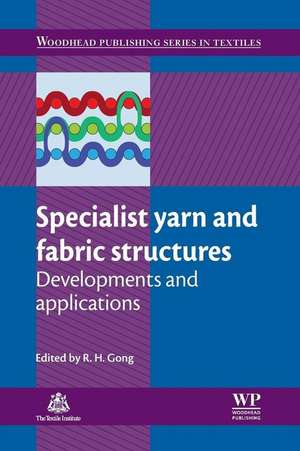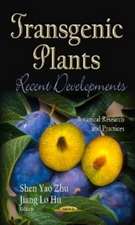Specialist Yarn and Fabric Structures: Developments and Applications: Woodhead Publishing Series in Textiles
Editat de R H Gongen Limba Engleză Paperback – 18 aug 2016
With its distinguished editor and international team of contributors, Specialist yarn, woven and fabric structures is essential reading for all textile researchers, technicians, engineers and technologies, and will also be suitable for academic purposes.
- Looks at developments that have occurred in the manufacturing of specialist yarn, weave and fabric structures
- Discusses different types of specialist yarn structures, such as hybrid, fancy and compound yarns
- Offers insight into multicomponent fabric structures such as 3D nonwovens, flocked, knotted and jacquard woven fabrics
Din seria Woodhead Publishing Series in Textiles
- 9%
 Preț: 947.93 lei
Preț: 947.93 lei - 9%
 Preț: 802.07 lei
Preț: 802.07 lei - 24%
 Preț: 802.53 lei
Preț: 802.53 lei - 9%
 Preț: 1158.65 lei
Preț: 1158.65 lei - 19%
 Preț: 340.02 lei
Preț: 340.02 lei - 24%
 Preț: 1133.92 lei
Preț: 1133.92 lei - 24%
 Preț: 1276.30 lei
Preț: 1276.30 lei - 24%
 Preț: 1132.28 lei
Preț: 1132.28 lei - 24%
 Preț: 949.23 lei
Preț: 949.23 lei - 24%
 Preț: 1162.55 lei
Preț: 1162.55 lei - 9%
 Preț: 1007.18 lei
Preț: 1007.18 lei - 24%
 Preț: 863.89 lei
Preț: 863.89 lei - 24%
 Preț: 1131.24 lei
Preț: 1131.24 lei - 9%
 Preț: 947.06 lei
Preț: 947.06 lei - 9%
 Preț: 1021.10 lei
Preț: 1021.10 lei - 9%
 Preț: 951.37 lei
Preț: 951.37 lei - 24%
 Preț: 1067.05 lei
Preț: 1067.05 lei - 24%
 Preț: 1511.33 lei
Preț: 1511.33 lei - 24%
 Preț: 1131.59 lei
Preț: 1131.59 lei - 9%
 Preț: 865.84 lei
Preț: 865.84 lei - 24%
 Preț: 1195.56 lei
Preț: 1195.56 lei - 23%
 Preț: 911.09 lei
Preț: 911.09 lei - 24%
 Preț: 1027.26 lei
Preț: 1027.26 lei - 29%
 Preț: 845.48 lei
Preț: 845.48 lei - 24%
 Preț: 1232.53 lei
Preț: 1232.53 lei - 9%
 Preț: 1007.18 lei
Preț: 1007.18 lei - 20%
 Preț: 1125.16 lei
Preț: 1125.16 lei - 20%
 Preț: 1185.64 lei
Preț: 1185.64 lei - 9%
 Preț: 1272.93 lei
Preț: 1272.93 lei - 31%
 Preț: 1090.57 lei
Preț: 1090.57 lei - 9%
 Preț: 1156.05 lei
Preț: 1156.05 lei - 24%
 Preț: 1159.97 lei
Preț: 1159.97 lei - 5%
 Preț: 838.79 lei
Preț: 838.79 lei - 39%
 Preț: 803.30 lei
Preț: 803.30 lei - 9%
 Preț: 1092.20 lei
Preț: 1092.20 lei - 29%
 Preț: 1426.03 lei
Preț: 1426.03 lei - 23%
 Preț: 309.98 lei
Preț: 309.98 lei - 20%
 Preț: 883.71 lei
Preț: 883.71 lei - 24%
 Preț: 924.65 lei
Preț: 924.65 lei - 29%
 Preț: 1210.65 lei
Preț: 1210.65 lei - 5%
 Preț: 1001.89 lei
Preț: 1001.89 lei - 9%
 Preț: 726.56 lei
Preț: 726.56 lei - 31%
 Preț: 728.30 lei
Preț: 728.30 lei - 39%
 Preț: 899.39 lei
Preț: 899.39 lei - 9%
 Preț: 986.86 lei
Preț: 986.86 lei - 24%
 Preț: 988.42 lei
Preț: 988.42 lei - 9%
 Preț: 1045.16 lei
Preț: 1045.16 lei - 9%
 Preț: 1167.80 lei
Preț: 1167.80 lei
Preț: 899.92 lei
Preț vechi: 988.92 lei
-9% Nou
Puncte Express: 1350
Preț estimativ în valută:
172.20€ • 180.25$ • 143.32£
172.20€ • 180.25$ • 143.32£
Carte tipărită la comandă
Livrare economică 24 martie-07 aprilie
Preluare comenzi: 021 569.72.76
Specificații
ISBN-13: 9780081016817
ISBN-10: 0081016816
Pagini: 384
Dimensiuni: 156 x 234 x 20 mm
Greutate: 0.54 kg
Editura: ELSEVIER SCIENCE
Seria Woodhead Publishing Series in Textiles
ISBN-10: 0081016816
Pagini: 384
Dimensiuni: 156 x 234 x 20 mm
Greutate: 0.54 kg
Editura: ELSEVIER SCIENCE
Seria Woodhead Publishing Series in Textiles
Cuprins
Contributor contact details
Woodhead Publishing Series in Textiles
Chapter 1: Compound yarns
Abstract:
1.1 Introduction
1.2 Types of compound yarns
1.3 Production methods for compound yarns
1.4 Applications of compound yarns
1.5 Future trends in compound yarns
Chapter 2: Developments in hybrid yarns
Abstract:
2.1 Introduction
2.2 Types of hybrid yarns and their development
2.3 Basic structures and properties of hybrid yarns
2.4 Production methods for hybrid yarns
2.5 Applications of hybrid yarns
2.6 Future trends in hybrid yarns
2.7 Acknowledgements
Chapter 3: Developments in rope structures and technology
Abstract:
3.1 Introduction
3.2 New fibres
3.3 Laid ropes
3.4 Braided ropes
3.5 Low-twist ropes
3.6 Manufacturing technology
3.7 Terminations
3.8 Uses of ropes
3.9 Conclusions
Chapter 4: Developments in fancy yarns
Abstract:
4.1 Introduction to fancy yarns
4.2 Historical development
4.3 Types of fancy yarns and their development
4.4 Production methods for fancy yarns
4.5 Applications for fancy yarns
4.6 Future trends in fancy yarns
4.7 Sources of further information and advice
Chapter 5: Developments in 3D knitted structures
Abstract:
5.1 Introduction to 3D knitted structures
5.2 Multiaxial warp-knitted fabrics
5.3 Space fabrics (or sandwich fabrics)
5.4 Fully-fashioned 3D knitted fabrics (or near-net-shaped knitted fabrics)
Chapter 6: Developments in leno-weave fabrics
Abstract:
6.1 Introduction to leno-weave fabrics
6.2 The structure of leno-weave fabrics
6.3 Fabrics with leno-weave
6.4 The production of leno-weave fabric
6.5 Properties of leno-weave fabrics
6.6 Applications of leno-weave fabrics
6.7 Future trends in leno-weave fabrics
Chapter 7: Developments in triaxial woven fabrics
Abstract:
7.1 Introduction
7.2 Basic patterns
7.3 A history of triaxial woven fabrics
7.4 Classification
7.5 Variations
7.6 Properties
7.7 Advantages
7.8 Applications
7.9 Aesthetics
7.10 Manufacturing
7.11 Future trends
7.12 Sources of further information and advice
Chapter 8: Interwoven fabrics and their applications
Abstract:
8.1 Introduction
8.2 Structure and design
8.3 Properties and applications
8.4 Future trends
Chapter 9: Pile carpets
Abstract:
9.1 Market background
9.2 Environmental considerations
9.3 Pile fibres
9.4 Pile yarns
9.5 Tufting
9.6 Backing materials, back-coating and laminating
9.7 Wireloom weaving
9.8 Face-to-face weaving
9.9 Axminster weaving
9.10 Needling
9.11 Other methods of manufacture
9.12 Coloration
9.13 Chemical and other treatments
9.14 Textile sports surfaces
9.15 Sources of further information and advice
Chapter 10: Developments in Jacquard woven fabrics
Abstract:
10.1 Introduction to Jacquard woven fabrics
10.2 Jacquard construction
10.3 Converting artwork to woven Jacquard patterns
10.4 Recent developments in Jacquard systems
10.5 Patterns in Jacquard woven fabrics
10.6 Applications of Jacquard woven fabrics
10.7 Relationship between structures and properties of Jacquard woven fabrics
10.8 Future trends in Jacquard woven fabrics
10.9 Sources of further information and advice
Chapter 11: Developments in 3D nonwovens
Abstract:
11.1 Introduction
11.2 High-bulk flat nonwovens
11.3 Shaped 3D nonwovens
11.4 Future trends
Chapter 12: Flocked fabrics and structures
Abstract:
12.1 Introduction
12.2 The theory of fiber coating
12.3 Flock fibers and preparation
12.4 Flocking substrates
12.5 Adhesives for flocking
12.6 Flocking processes
12.7 Testing and quality assurance
12.8 New developments in the application of flocked fabrics and structures
12.9 Conclusions and future trends
12.10 Sources of further information and advice
12.11 Acknowledgements
Chapter 13: Knotted fabrics
Abstract:
13.1 Introduction
13.2 Types of knotted fabrics
13.3 Production methods for knotted fabrics
13.4 Applications for knotted fabrics
13.5 Future trends for knotted fabrics
Chapter 14: Developments in braided fabrics
Abstract:
14.1 Introduction
14.2 Braiding
14.3 Classifying braids
14.4 The geometry of the braided structure
14.5 Applications of braided fabrics
14.6 Future trends in braided fabrics
Index
Woodhead Publishing Series in Textiles
Chapter 1: Compound yarns
Abstract:
1.1 Introduction
1.2 Types of compound yarns
1.3 Production methods for compound yarns
1.4 Applications of compound yarns
1.5 Future trends in compound yarns
Chapter 2: Developments in hybrid yarns
Abstract:
2.1 Introduction
2.2 Types of hybrid yarns and their development
2.3 Basic structures and properties of hybrid yarns
2.4 Production methods for hybrid yarns
2.5 Applications of hybrid yarns
2.6 Future trends in hybrid yarns
2.7 Acknowledgements
Chapter 3: Developments in rope structures and technology
Abstract:
3.1 Introduction
3.2 New fibres
3.3 Laid ropes
3.4 Braided ropes
3.5 Low-twist ropes
3.6 Manufacturing technology
3.7 Terminations
3.8 Uses of ropes
3.9 Conclusions
Chapter 4: Developments in fancy yarns
Abstract:
4.1 Introduction to fancy yarns
4.2 Historical development
4.3 Types of fancy yarns and their development
4.4 Production methods for fancy yarns
4.5 Applications for fancy yarns
4.6 Future trends in fancy yarns
4.7 Sources of further information and advice
Chapter 5: Developments in 3D knitted structures
Abstract:
5.1 Introduction to 3D knitted structures
5.2 Multiaxial warp-knitted fabrics
5.3 Space fabrics (or sandwich fabrics)
5.4 Fully-fashioned 3D knitted fabrics (or near-net-shaped knitted fabrics)
Chapter 6: Developments in leno-weave fabrics
Abstract:
6.1 Introduction to leno-weave fabrics
6.2 The structure of leno-weave fabrics
6.3 Fabrics with leno-weave
6.4 The production of leno-weave fabric
6.5 Properties of leno-weave fabrics
6.6 Applications of leno-weave fabrics
6.7 Future trends in leno-weave fabrics
Chapter 7: Developments in triaxial woven fabrics
Abstract:
7.1 Introduction
7.2 Basic patterns
7.3 A history of triaxial woven fabrics
7.4 Classification
7.5 Variations
7.6 Properties
7.7 Advantages
7.8 Applications
7.9 Aesthetics
7.10 Manufacturing
7.11 Future trends
7.12 Sources of further information and advice
Chapter 8: Interwoven fabrics and their applications
Abstract:
8.1 Introduction
8.2 Structure and design
8.3 Properties and applications
8.4 Future trends
Chapter 9: Pile carpets
Abstract:
9.1 Market background
9.2 Environmental considerations
9.3 Pile fibres
9.4 Pile yarns
9.5 Tufting
9.6 Backing materials, back-coating and laminating
9.7 Wireloom weaving
9.8 Face-to-face weaving
9.9 Axminster weaving
9.10 Needling
9.11 Other methods of manufacture
9.12 Coloration
9.13 Chemical and other treatments
9.14 Textile sports surfaces
9.15 Sources of further information and advice
Chapter 10: Developments in Jacquard woven fabrics
Abstract:
10.1 Introduction to Jacquard woven fabrics
10.2 Jacquard construction
10.3 Converting artwork to woven Jacquard patterns
10.4 Recent developments in Jacquard systems
10.5 Patterns in Jacquard woven fabrics
10.6 Applications of Jacquard woven fabrics
10.7 Relationship between structures and properties of Jacquard woven fabrics
10.8 Future trends in Jacquard woven fabrics
10.9 Sources of further information and advice
Chapter 11: Developments in 3D nonwovens
Abstract:
11.1 Introduction
11.2 High-bulk flat nonwovens
11.3 Shaped 3D nonwovens
11.4 Future trends
Chapter 12: Flocked fabrics and structures
Abstract:
12.1 Introduction
12.2 The theory of fiber coating
12.3 Flock fibers and preparation
12.4 Flocking substrates
12.5 Adhesives for flocking
12.6 Flocking processes
12.7 Testing and quality assurance
12.8 New developments in the application of flocked fabrics and structures
12.9 Conclusions and future trends
12.10 Sources of further information and advice
12.11 Acknowledgements
Chapter 13: Knotted fabrics
Abstract:
13.1 Introduction
13.2 Types of knotted fabrics
13.3 Production methods for knotted fabrics
13.4 Applications for knotted fabrics
13.5 Future trends for knotted fabrics
Chapter 14: Developments in braided fabrics
Abstract:
14.1 Introduction
14.2 Braiding
14.3 Classifying braids
14.4 The geometry of the braided structure
14.5 Applications of braided fabrics
14.6 Future trends in braided fabrics
Index









